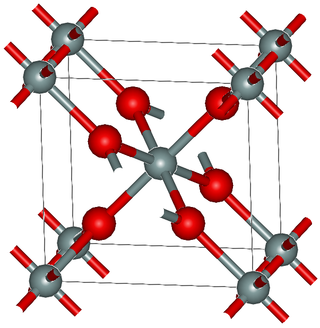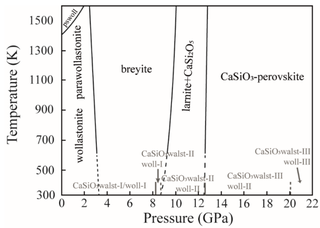Related Research Articles

Moissanite is naturally occurring silicon carbide and its various crystalline polymorphs. It has the chemical formula SiC and is a rare mineral, discovered by the French chemist Henri Moissan in 1893. Silicon carbide is useful for commercial and industrial applications due to its hardness, optical properties and thermal conductivity.

Stishovite is an extremely hard, dense tetragonal form (polymorph) of silicon dioxide. It is very rare on the Earth's surface; however, it may be a predominant form of silicon dioxide in the Earth, especially in the lower mantle.

Troilite is a rare iron sulfide mineral with the simple formula of FeS. It is the iron-rich endmember of the pyrrhotite group. Pyrrhotite has the formula Fe(1-x)S which is iron deficient. As troilite lacks the iron deficiency which gives pyrrhotite its characteristic magnetism, troilite is non-magnetic.

Birnessite (nominally MnO2·nH2O), also known as δ-MnO2, is a hydrous manganese dioxide mineral with a chemical formula of Na0.7Ca0.3Mn7O14·2.8H2O. It is the main manganese mineral species at the Earth's surface, and commonly occurs as fine-grained, poorly crystallized aggregates in soils, sediments, grain and rock coatings (e.g., desert varnish), and marine ferromanganese nodules and crusts. It was discovered at Birness, Aberdeenshire, Scotland.

Ringwoodite is a high-pressure phase of Mg2SiO4 (magnesium silicate) formed at high temperatures and pressures of the Earth's mantle between 525 and 660 km (326 and 410 mi) depth. It may also contain iron and hydrogen. It is polymorphous with the olivine phase forsterite (a magnesium iron silicate).

Mackinawite is an iron nickel sulfide mineral with the chemical formula (Fe,Ni)
1+xS. The mineral crystallizes in the tetragonal crystal system and has been described as a distorted, close packed, cubic array of S atoms with some of the gaps filled with Fe. Mackinawite occurs as opaque bronze to grey-white tabular crystals and anhedral masses. It has a Mohs hardness of 2.5 and a specific gravity of 4.17. It was first described in 1962 for an occurrence in the Mackinaw mine, Snohomish County, Washington for which it was named.

Khatyrkite is a rare mineral which is mostly composed of copper and aluminium, but may contain up to about 15% of zinc or iron. Its chemical structure is described by an approximate formula (Cu,Zn)Al2 or (Cu,Fe)Al2. It was discovered in 1985 in a placer in association with another rare mineral cupalite. These two minerals have only been found at 62°39′11″N174°30′02″E in the area of the Iomrautvaam, a tributary of the Khatyrka river, in the Koryak Mountains, in Anadyrsky District, Chukotka, Russia. Analysis of one of the samples containing khatyrkite showed that the small rock was from a meteorite. A geological expedition has identified the exact place of the original discovery and found more specimens of the Khatyrka meteorite. The mineral's name derives from the Khatyrka zone where it was discovered. Its type specimen is preserved in the Mining Museum in Saint Petersburg, and parts of it can be found in other museums, such as Museo di Storia Naturale di Firenze.

Chamosite is the Fe2+end member of the chlorite group. A hydrous aluminium silicate of iron, which is produced in an environment of low to moderate grade of metamorphosed iron deposits, as gray or black crystals in oolitic iron ore. Like other chlorites, it is a product of the hydrothermal alteration of pyroxenes, amphiboles and biotite in igneous rock. The composition of chlorite is often related to that of the original igneous mineral so that more Fe-rich chlorites are commonly found as replacements of the Fe-rich ferromagnesian minerals (Deer et al., 1992).

Seifertite is a silicate mineral with the formula SiO2 and is one of the densest polymorphs of silica. It has only been found in Martian and lunar meteorites, where it is presumably formed from either tridymite or cristobalite – other polymorphs of quartz – as a result of heating during the atmospheric re-entry and impact to the Earth, at an estimated minimal pressure of 35 GPa. It can also be produced in the laboratory by compressing cristobalite in a diamond anvil cell to pressures above 40 GPa. The mineral is named after Friedrich Seifert (born 1941), the founder of the Bayerisches Geoinstitut at University of Bayreuth, Germany, and is officially recognized by the International Mineralogical Association.
Krotite is a natural mineral composed of calcium, aluminium and oxygen, with the molecular formula CaAl2O4. It is the low-pressure dimorph of CaAl2O4, of which the high-pressure dimorph is named dmitryivanovite.
Dmitryivanovite is a natural mineral composed of calcium, aluminium and oxygen, with the molecular formula CaAl2O4. It was reported in 2009 in a calcium-aluminium-rich inclusion in the carbonaceous chondrite meteorite 470 (NWA470) CH3, which landed in North Africa. The mineral name was chosen to honor Dmitriy A. Ivanov (1962–1986), a geologist, mineralogist, and petrologist who died on a field expedition.

Icosahedrite is the first known naturally occurring quasicrystal phase. It has the composition Al63Cu24Fe13 and is a mineral approved by the International Mineralogical Association in 2010. Its discovery followed a 10-year-long systematic search by an international team of scientists led by Luca Bindi and Paul J. Steinhardt to find the first natural quasicrystal.

Sinoite is rare mineral with the chemical formula Si2N2O. It was first found in 1905 in chondrite meteorites and identified as a distinct mineral in 1965. Sinoite crystallizes upon meteorite impact as grains smaller than 0.2 mm surrounded by Fe-Ni alloys and the mineral enstatite. It is named after its SiNO composition and can be prepared in the laboratory as a silicon oxynitride ceramic.

The Zakłodzie meteorite is a stony-iron meteorite found in Poland in 1998. Its mass is 8.68 kilograms (19.1 lb). It is composed predominantly from enstatite and meteoric iron. Currently classified as an ungrouped enstatite achondrite its classification is still an ongoing scientific debate.

Tetrataenite is a native metal alloy composed of chemically-ordered L10-type FeNi, recognized as a mineral in 1980. The mineral is named after its tetragonal crystal structure and its relation to the iron-nickel alloy, taenite. It is one of the mineral phases found in meteoric iron.
Merrillite is a calcium phosphate mineral with the chemical formula Ca9NaMg(PO4)7. It is an anhydrous, sodium-rich member of the merrillite group of minerals.
The Wedderburn meteorite is an iron meteorite discovered in 1951 near the town of Wedderburn in the state of Victoria, Australia.

Fumarole minerals are minerals which are deposited by fumarole exhalations. They form when gases and compounds desublimate or precipitate out of condensates, forming mineral deposits. They are mostly associated with volcanoes following deposition from volcanic gas during an eruption or discharge from a volcanic vent or fumarole, but have been encountered on burning coal deposits as well. They can be black or multicoloured and are often unstable upon exposure to the atmosphere.

Breyite is a high pressure calcium silicate mineral (CaSiO3) found in diamond inclusions. It is the second most abundant inclusion after ferropericlase, for diamonds with a deep Earth origin. Its occurrence can also indicate the host diamond's super-deep origin. This mineral is named after German mineralogist, petrologist and geochemist Gerhard P. Brey.
The arsenite bromides are mixed anion compounds containing both arsenite and bromide ions. Similar compounds include arsenate bromides, arsenite chlorides, antimonite bromides, antimonite chlorides, and ...
References
- ↑ Warr, L.N. (2021). "IMA–CNMNC approved mineral symbols". Mineralogical Magazine. 85 (3): 291–320. Bibcode:2021MinM...85..291W. doi: 10.1180/mgm.2021.43 . S2CID 235729616.
- 1 2 3 Mindat
- 1 2 Webmineral data
- 1 2 Britvin, Sergey N.; Vereshchagin, Oleg S.; Shilovskikh, Vladimir V.; Krzhizhanovskaya, Maria G.; Gorelova, Liudmila A.; Vlasenko, Natalia S.; Pakhomova, Anna S.; Zaitsev, Anatoly N.; Zolotarev, Andrey A.; Bykov, Maxim; Lozhkin, Maksim S.; Nestola, Fabrizio (2021). "Discovery of terrestrial allabogdanite (Fe,Ni)2P, and the effect of Ni and Mo substitution on the barringerite-allabogdanite high-pressure transition". American Mineralogist. 106 (6): 944–952. Bibcode:2021AmMin.106..944B. doi:10.2138/am-2021-7621. S2CID 226434207.
- ↑ Britvin, Sergey N.; Rudashevsky, Nikolay S.; Krivovichev, Sergey V.; Burns, Peter C.; Polekhovsky, Yury S. (2002). "Allabogdanite, (Fe,Ni)2P, a new mineral from the Onello meteorite: The occurrence and crystal structure". American Mineralogist. 87 (8–9): 1245–1249. Bibcode:2002AmMin..87.1245B. doi:10.2138/am-2002-8-924. S2CID 99564642.